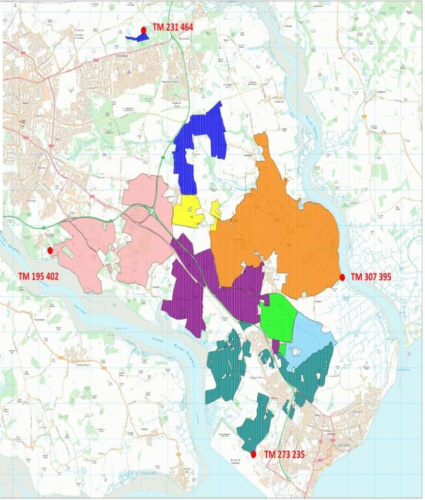Ref: CSFF090006
Lead: AJ, aj@broxtead.com
Group members: 8
Length of agreement: 5
Area of group (Hectares): 3682
Priorities
- To help restore/maintain the Orwell and Deben Estuary SPA, Ramsar and SSSI sites and Special Areas of Conservation, Loam pit Lake SSSI, Sinks Pit [part of Sinks Valley SSSI] and Newbourne Springs SSSI plus several CWS; to protect the unique landscape characteristic and increase biodiversity:
- Maintain, restore or enlarge priority habitats: Dry acid grassland; Lowland heathland [successfully seeded at Nacton]; Lowland meadows; Coastal & floodplain grazing marsh; Saltmarsh; Reedbeds; Riparian habitats; Traditional orchards; Deciduous woodland; Arable field margins; Wood-pasture and Parkland.
- Provide/improve habitat for the following: Arable – Lapwing, Corn Bunting, Stone Curlew [on eastern edge of peninsular, Turtle Dove, Tree Sparrow [Levington], Grey Partridge, Yellow Wagtail and Linnet. Heathland – Dartford Warbler [Bixley], Adder [Nacton]. Woodland – Marsh Tit, Spotted Flycatcher, Tree Creeper, Lesser Spotted Woodpecker, Hobby. Breeding Waders – Curlew, Black-tailed Godwit, Snipe, Oystercatcher, Redshank. Bittern at Mill River. Arable plant assemblage – Corn Marigold, Corn Spurrey, Small-flowered catch fly, Sticky catch-fly, Smooth Cats-ear, Field Madder, Sharp-leaved Fluellen, Dwarf spurge.
- To enhance arable/grassland habitat, increase biodiversity and provide corridors for species to move freely during climatic change: Establish nectar and wild bird seed plots and upgrade grassy field corners/margins into flower rich areas. Create fallow plots for breeding lapwing, stone curlew / rare arable plants. Leave small bare areas near field edges and alongside track ways. Restore hedgerows. Improve grassland management and maintain/restore historic parkland.
- To improve water quality, reduce soil erosion, and preserve landscape features: 1. Control the source/ movement of pollutants (nutrient, sediment and pesticides), surface water and sediments. 2. Improve soil management particularly in relation to outdoor pigs. 3. Buffer wetland habitat such as coastal and floodplain grazing marsh and reedbed. 4. Use green cover on arable fields. 5. Improve riparian management.
- To help maintain the unique landscape, improve water quality, increase biodiversity, lower flood risk and offset climate change effects: 1. Actively manage woodland. 2. Work together to control bracken and invasive non-native species. 3. Buffer historic features. 4. Maintain/restore historic parklands. 5. Buffer historic features.

